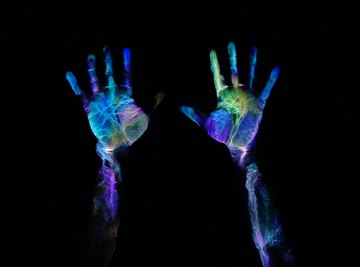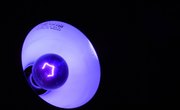
Fingerprinting is the heart of criminal investigations, because everyone has a unique set of prints that remain with them, unchanged, throughout their lifetime. Because oils and residues typically reside in the skin, fingerprints are easily transferable to almost any surface you touch. Some surfaces create more of a challenge when detecting fingerprints, such as a highly contrasting printed page or porous surfaces. Using ultraviolet light — also called a black light — with fluorescent powders or solutions helps to bring out the prints and allow them to be photographed.
- Fluorescent powder or solution
- Yellow or 2-A haze barrier filters
- Camera
- Ultraviolet protective goggles
Spray or immerse the object to be fingerprinted in a fluorescent solution for five seconds to two minutes, depending on the solution. A good choice for standard black lights are ardrox, basic yellow 40 and thenoyl europium chelate, because they react to lower wavelength ultraviolet lights. Follow specific instructions for the chemical used.
Lower the ambient light in the area.
Put on your ultraviolet protective goggles.
Shine the black light on the object to look for fingerprints. The prints should glow from the reaction between the fluorescent solution and the black light.
Place the yellow or 2-A haze barrier filter on your camera to enhance detail.
Photograph the prints in close detail for later analysis.
Things You'll Need
References
- International Association for Identification: Latent Fingerprint Processing Techniques; Selection & Sequencing Guide
- International Association for Identification: Ultraviolet Examination
- International Association for Identification: Ardrox Formula
- International Association for Identification: Basic Yellow 40 Formula
- International Association for Identification: Thenoyl Europium Chelate Formula
About the Author
C. Taylor embarked on a professional writing career in 2009 and frequently writes about technology, science, business, finance, martial arts and the great outdoors. He writes for both online and offline publications, including the Journal of Asian Martial Arts, Samsung, Radio Shack, Motley Fool, Chron, Synonym and more. He received a Master of Science degree in wildlife biology from Clemson University and a Bachelor of Arts in biological sciences at College of Charleston. He also holds minors in statistics, physics and visual arts.
